Cork Travel Guide
The Republic of Ireland's second largest city Cork is situated on an estuary that opens onto the Atlantic Ocean, and has been likened to Dublin without the traffic. Crammed with cosy pubs and cultural attractions, it is a charming and popular destination to add to the itinerary.
There is a great rivalry between Cork and Dublin, and the majority of Cork's residents see themselves as distinctly different from the rest of Ireland. Cork is vibrant and cheerful, with music, theatre and film all playing a major role in city life. World-renowned annual festivals add to the lively atmosphere and, in 2005, it was named the European Capital of Culture.
Cork is also the gastronomic capital of Ireland, with the widest variety of top-class restaurants in the country. Nearby Kinsale, also known for its host of award-winning pubs and restaurants, hosts the annual Gourmet Festival.
County Cork is located in the southwest, and it is the largest county in Ireland. It's noted for its maritime identity and impressive coastal scenery as well as being the site of Ireland's most famous attraction, the Blarney Stone. The city is a major seaport and is built around the waterways of the River Lee, connected by numerous bridges. Cork harbour is one of the largest natural harbours in the world.
The hip and historic Victorian Quarter is perhaps the best place to stay for first-time visitors. It's right by the main rail and bus station, and taxis are easy to find, making it an ideal base from which to discover Cork. The neighborhood gets its name from the architecture of the buildings, which are laid out in an elegant Victorian style. Saint Luke's is best for those visiting on a budget. Located to the east of the Victorian Quarter, it's a more residential area, though it's also the site of a fair number of pubs and restaurants. Shandon is a good choice for those visiting with children, as it's where a lot of the tourist destinations are. The city centre is perfect for travellers who are interested in the nightlife.
Things to do in Cork
When deciding what to see in Cork, it is a good idea to keep itineraries flexible to compensate for the unpredictable Irish weather. However, there are plenty of indoor and outdoor attractions. Popular things to see in Cork include the 19th-century Cork City Gaol, the protestant Finbarr's Cathedral, the Church Tower of Shandon, and the Cork Museum, which is largely given over to the nationalist struggle in which Cork played an important role.The Old English Market is a foodies dream, with top-quality fresh produce of all kinds. There's also Patrick Street, a road full to bursting with restaurants and shops and with many quaint pedestrianised side streets.
Cork is a wonderful base for exploration in the south of Ireland. Blarney Castle, one of Ireland's most famous attractions, is just outside of the city and dates back to 1446. Popular day trips from Cork include Kinsale, a picturesque and interesting coastal village known for its culinary delights, and the beautiful coastal scenery of County Kerry, including the Dingle Peninsula.
Cork is known to have less traffic than Dublin and it is relatively easy to navigate. For this reason, and because visitors usually intend to explore the many wonders beyond the city, visitors often choose to hire a car. However, Cork has a decent public transport system and visitors won't struggle to get from attraction to attraction within the city.
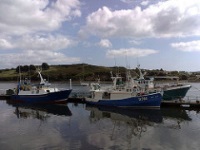
Kinsale
Kinsale is an old fishing village just 18 miles (29km) south of Cork. It's best known for the world renowned Old Head Golf Links, which are set on a narrow head jutting out into the Celtic Sea. Kinsale has a number of interesting sights, including The Courthouse and Desmond Castle.
Desmond Castle was built as a custom house by the Earl of Desmond in the 16th century. It has a colourful history, ranging from Spanish occupation during the Battle of Kinsalein in 1601, to its use as a prison for captured American sailors during the American War of Independence. It is known locally as 'The French Prison' after a tragic fire in which 54 prisoners, mainly French seamen, died in 1747. The castle was also used as a borough jail from 1791 to the beginning of the Great Famine, when it became an auxiliary workhouse tending to the starving populace.
Charles Fort is two miles (3km) outside Kinsale. Constructed in the late 17th century on the site of an earlier coastal fortification, it is a classic example of a star-shaped fort. William Robinson, architect of the Royal Hospital in Kilmainham, Dublin, and Superintendent of Fortifications, is credited with its design. As one of the largest military forts in the country, Charles Fort has been associated with some of the most momentous events in Irish history, the most significant of which include the Williamite War in 1690 and the Irish Civil War in 1922 to 1923. James Fort sits across the estuary. It is an earlier structure that was designed by Paul Ive in 1602.
Kinsale has also earned itself a reputation as Ireland's gourmet centre, with numerous award-winning pubs and restaurants, and the annual Gourmet Festival in October.
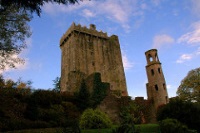
Blarney Castle
Built around 1446, Blarney Castle is one of Ireland's oldest and most historic castles. An ancient stronghold of the MacCarthys, Lords of Muskerry, and one of the strongest fortresses in Munster, its walls are 18ft (5m) thick in places. Located on the parapet of the castle is the famous 'Blarney Stone'. According to local legend, after kissing this stone, one will have the gift of eternal eloquence, or 'the gift of the gab'. To do this, visitors must first position themselves on their back, then lean their head back and downwards over the edge of the battlements, with the help of an attendant, in order to kiss the underside of the stone. This is a rather scary process but the fear is part of the thrill.
The grounds of this magnificent ruin are an attraction in themselves, with well-maintained pathways and great natural features that are worth exploring for several hours. There is a Poison Garden full of dangerous and deadly plants, and a magical rock passageway. Visitors should walk down the Witch's Steps backwards for good luck!
Blarney Castle is one of Ireland's most famous attractions and it can get very crowded in the summer season. Guests should visit early to avoid queuing for entry and to kiss the stone. The last admission to the castle and grounds is 30 minutes before closing.
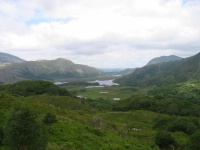
County Kerry
Kerry County is widely regarded as the most beautiful region in Ireland. It's the country's most popular tourist destination with its rugged scenery, picturesque villages, coastal resorts and wealth of attractions. The panoramic Ring of Kerry drive on the Iveragh Peninsula affords spectacular views of Ireland's highest mountain, the Lakes of Killarney, and the stunning coastal scenery. There are also many ancient and historic sites along the way, including the incredible ruins on the Skellig islands. The Killarney National Park is also renowned for its beauty and variety of outdoor activities. The Dingle Peninsula has magnificent coastal scenery and is the westernmost point of Europe. Villages like Kenmare and Dingle offer a wonderful glimpse of traditional Irish life. Fresh seafood and authentic music make any visit a delight.
County Kerry is a paradise for outdoor enthusiasts, ideal for boating, fishing, walking, golfing and cycling. The Ring of Kerry is best enjoyed during the summer months as bad weather reduces visibility. Even in thick fog, it is an enchanting region that makes its way onto most Irish travel itineraries and seldom disappoints.
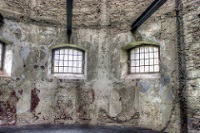
Old City Gaol
The old Cork City Gaol looks the same as it did in Victorian times, with its barred windows, cells, bare corridors and iron stairways behind the unwelcoming gateway. The gaol once incarcerated 19th century prisoners. The building was built in 1824 and is considered one of the finest examples of Georgian architecture surviving in Cork.
Self-guided audio tours are an option. Life-size figures, sounds and exhibitions tell the story and social history of 19th century Cork and the reasons people turned to crime, which was mainly due to extreme poverty. Visitors can still see the graffiti that prisoners carved or wrote on the walls, and there are many interesting facts and stories to be heard. Unsurprisingly, the Cork City Gaol is said to be haunted, which is very easy to believe when strolling through the formidable building.
The tour is available in 13 languages and it really does transport visitors into another century. Children will enjoy this attraction and it is a good activity for the whole family. Although it is popular, it never seems too crowded, which adds to the eerie atmosphere.
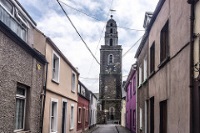
Church Tower of Shandon
Positioned on a hill overlooking the River Lee, the Church Tower of Shandon (Old Fort) is possibly Cork's most famous landmark. The red sandstone and white limestone tower is crowned by a large, salmon-shaped weather vane. It was built in 1722, making it one of Cork's oldest buildings, and is still perfectly preserved. The Church of St Anne is famous for its bells, which inspired the song 'The Bells of Shandon', and also for its clock, which is referred to as 'the four-faced liar' because each of its four faces reads a different time. Visitors can ring the famous bells on a visit to St Anne's and view the internal workings of the clocks.
The views of the city from the bell tower's balcony are stunning. The staircase up to the top of the tower gets quite narrow, which is a delight for some but perhaps shouldn't be attempted by the claustrophobic. The church itself is also a joy to explore for those who are interested, and the people who work there are very helpful and friendly. The church is located in the historical section of the city, so a visit can be combined with a stroll through the charming old area, which has many other attractions.
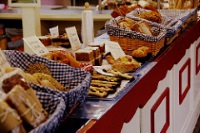
The English Market
The 16th century Princes Street Market is a covered food market in the centre of Cork. A large sign now designates it the Old English Market (and the nearby St Peter's Market is referred to locally as the Irish Market), although it is certainly Irish in character. The Queen and Prince Philip visited the market in June 2011, cementing its association with the English.
Merchandise on sale includes fresh fruit and vegetables, baked goods, cheese, meat, seafood, gourmet chocolate, sweets, clothes, and local crafts, trinkets and souvenirs. It is well known among locals and tourists alike for its varied selection of produce from all over the world, and especially for its fresh fish. The merchants are very friendly and the place has a wonderful atmosphere. It's a good idea to ask the stall owners for their recommendations and try out some local specialties. Visitors can buy a take-away meal, gifts for those back home, or groceries at the Old English Market. Those who enjoy the place should try the Farmgate Restaurant, where they can sit on the balcony overlooking the stalls and relish the smells and sights along with a great meal.
Getting Around
Local and regional bus transport is provided by Bus Eireann, with routes covering the city and linking Cork to surrounding suburbs. The main regional bus terminal is at Parnell Place in the city centre, with buses departing to various destinations in Ireland throughout the day. Tickets can be bought online, at booking offices or from the bus driver. It's a good idea to consider getting a Leap card, which entitles travellers to a discount, and means they don't need to carry cash.
Kent Station acts as the city's primary railway hub, with local and regional lines provided by Irish Rail. Three local lines connect Cork with Mallow to the north, Cobh to the southeast and Middleton to the east. Long-distance rail connects Cork to other major Irish cities. Tickets can be purchased online or at station booking offices.
Private taxi services operate throughout the city and cabs can either be booked in advance or hailed at taxi ranks throughout the city. There are several cycle routes within the city and bicycles can be hired from several outlets.
Cork Climate and Weather
Cork has a mild climate with plenty of rainfall throughout the year. Average temperatures are never too extreme and Cork often experiences a lot of fog, which is most common during mornings and during the winter months (November to February). Winter temperatures in Cork rarely drop below 32F (0C) and snow is rare in the city. There may be light snowfall occasionally during winter, but it is seldom thick enough to cover the ground. April is the driest month, and December is the wettest, but any visit to Cork may well involve rain.
Cork also experiences a lot of sunshine by Irish standards, and the summer months, between May and August, are the best time of year to visit Cork, just like they are the best time of year to visit any other Irish destination. Average summer temperatures in Cork range between 50F (10C) and 68F (20C). The peak tourist season is a bit more expensive than the off-season in Cork, so budget travellers may want to visit during autumn or winter. Visitors unfamiliar with the Irish climate should be warned that weather in Cork is extremely changeable and at any time of year they may experience four seasons in one day.
Ireland travel info
Electricity
Electrical current is 230 volts, 50Hz. UK-style three-pin and round three-pin plugs are in use.
Language
English is the principal language, although a minority of people speak Irish (Gaelic).
Money
The unit of currency is the Euro (EUR). Currency can be exchanged at banks and bureaux de change, and ATMs are widely available. Credit and debit cards are widely accepted.
Tipping
A 10 percent tip will be welcomed in restaurants and cafes, and occasionally a service charge will be added to the bill. Tipping is not usual in bars and pubs, or for other services.
Health
There are no special health requirements for visitors, though all eligible travellers should be up to date with their COVID-19 vaccines. A European Health Insurance Card (EHIC) should be obtained before departing for Ireland. After Brexit, the Global Health Insurance Card (GHIC) replaced the European Health Insurance Card (EHIC) for UK citizens. The GHIC allows UK citizens access to state healthcare during visits to the EU. The GHIC is not valid in Norway, Iceland, Liechtenstein or Switzerland, nor is it an alternative to travel insurance. Medical facilities are good and medicines are widely available; if travellers require specific medication, it is always advised that they bring it with them. Travellers should make sure to carry all medications in their original containers, clearly labeled. They should also have a signed, dated letter from their doctor describing all medical conditions and listing all prescribed medications, including generic names.
Safety
Most visitors to Ireland enjoy a fairly high level of personal safety. Ireland has a very low level of violent crime, but there is a high incidence of petty theft in tourist areas and foreigners are targeted by pick-pockets. Travellers should take sensible precautions against petty theft, including duplicating important documents, carrying valuables in separate bags or pockets, and leaving valuables in hotel safes whenever possible. Terrorism is no more a threat in Ireland than in other Western countries and safety in the country has improved significantly with peace in Northern Ireland. Those travelling into Northern Ireland should note that the safety alerts for that country are completely seperate and can be found in the United Kingdom travel guide.
Local customs
The Irish are warm and welcoming and their conversation is often light hearted and dosed with humour, irreverence and self-depreciation. A handshake is the normal form of greeting, though close friends will hug or kiss each other on the cheek. The pub remains at the centre of many communities, and alcohol may be bought by anyone over 18 years old. Smoking is not allowed in public spaces, including in pubs and restaurants. Visitors should refrain from forcing discussions of political and religious differences and show respect if the topics are brought up. Attitudes towards LGBT people are liberal and same-sex marriage is legal.
Doing business
The Irish are very sociable and, although the usual elements of business etiquette apply (punctuality, formal wear, a courteous manner), foreigners can expect good conversation and a rather relaxed air. Handshakes are customary on introduction, and foreigners should take the lead from the host with regards to using first names or surnames. Business hours are usually from 9am to 5.30pm Monday to Friday, with a lunch break from 1pm to 2pm.
Duty free
Travellers over 17 years old arriving from non-EU countries do not have to pay duty on most products. Regulations allow 200 cigarettes, 100 cigarillos, 50 cigars, 250g tobacco; one litre of spirits with more than 22 percent alcohol volume, two litres of dessert wine, port of sherry with a maximum 22 percent alcohol content; and four litres of wine or 16 litres of beer. Other duty free products include perfume up to 50g or 250ml eau de toilette; and other goods for personal consumption to the value of €430 per adult or €215 for children under 15 years.
Communications
The international access code for Ireland is +353. Hotels, cafes and restaurants offering free WiFi are widely available; purchasing a local prepaid SIM card can be a cheaper option than accepting international roaming costs, which can be high.
Passport & Visa
All foreign passengers to Ireland must be able to show proof of sufficient funds to cover their stay in the country. Passengers should also hold return or onward tickets, and the necessary travel documentation for their next destination, as immigration officers might demand that they demonstrate proof of their intention to leave Ireland. If the traveller's passport bears a British inadmissable stamp, unless the immigration officer is convinced that they will not travel on to the United Kingdom, entry may be refused to Ireland. It is highly recommended that travellers' passport have at least six months' validity remaining after the intended date of departure from their travel destination. Immigration officials often apply different rules to those stated by travel agents and official sources.
Entry requirements
US citizens must have a passport that is valid for the period of intended stay in Ireland. No visa required for 90 days.
British citizens must have a passport that is valid upon their arrival in Ireland. Passport exemptions apply to holders of proof of nationality issued to nationals of Ireland and British subjects, for travel between Ireland and Great Britain and Northern Ireland only. No visa is required for holders of British passports endorsed British Citizen, British National (Overseas), or British Overseas Territories Citizen.
Canadian citizens must have a passport that is valid for the period of intended stay in Ireland. No visa is required for 90 days.
Australian citizens must have a passport that is valid for the period of intended stay in Ireland. No visa is required for 90 days.
South African citizens must have a passport that is valid for the period of intended stay in Ireland. No visa is required for 90 days.
New Zealand citizens must have a passport that is valid for the period of intended stay in Ireland. No visa is required 90 days.
Useful contacts
Irish Tourist Office, Dublin: www.ireland.com
112 (general emergencies)Embassies / consulates in other countries
Irish Embassy, Washington DC, United States: +1 202 462 3939.
Irish Embassy, London, United Kingdom: +44 (0)20 7235 2171.
Irish Embassy, Ottawa, Canada: +1 613 233 6281.
Irish Embassy, Canberra, Australia: +61 (0)2 6214 0000.
Irish Embassy, Pretoria, South Africa: +27 (0)12 452 1000.
Consulate-General of Ireland, Auckland, New Zealand: +64 (0)9 977 2252.
Embassies / consulates in Ireland
United States Embassy, Dublin: +353 (0)1 668 8777.
British Embassy, Dublin: +353 (0)1 205 3700.
Canadian Embassy, Dublin: +353 (0)1 234 4000.
Australian Embassy, Dublin: +353 (0)1 664 5300.
South African Embassy, Dublin: +353 (0)1 661 5553.
New Zealand High Commission, London, United Kingdom (also responsible for Ireland): +44 (0)20 7930 8422.



